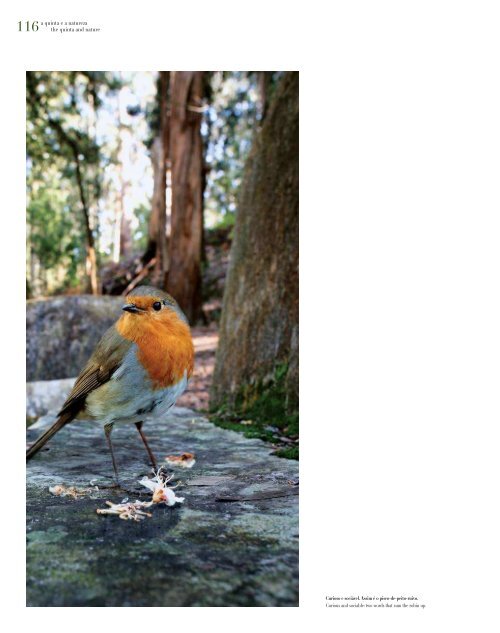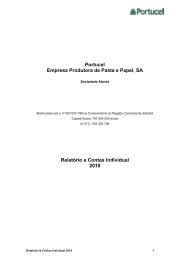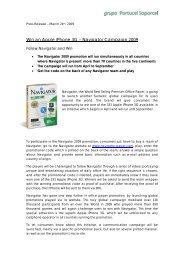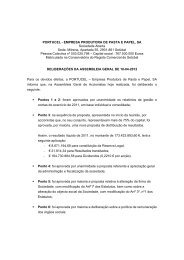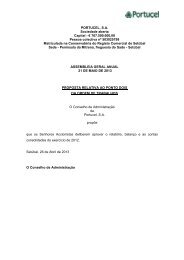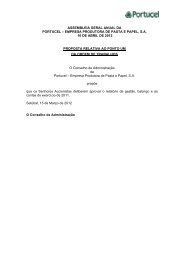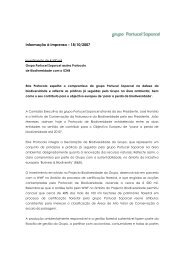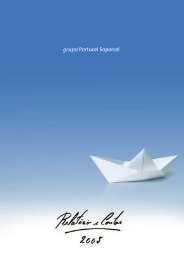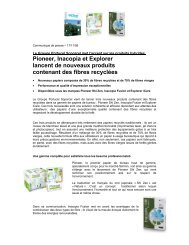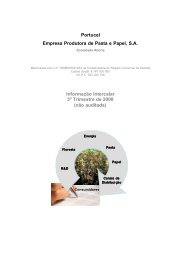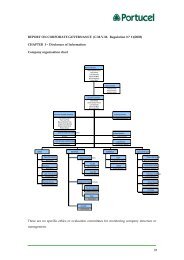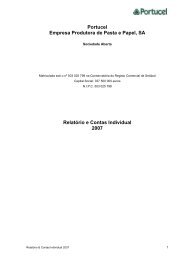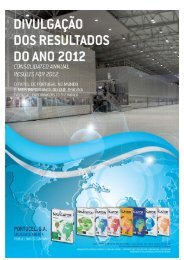Os Eucaliptos e as Aves da Quinta de São Francisco
Os Eucaliptos e as Aves da Quinta de São Francisco
Os Eucaliptos e as Aves da Quinta de São Francisco
You also want an ePaper? Increase the reach of your titles
YUMPU automatically turns print PDFs into web optimized ePapers that Google loves.
a quinta e a natureza<br />
a quinta e a natureza<br />
116 the quinta and nature the quinta and nature 117<br />
Curioso e sociável. Assim é o pisco-<strong>de</strong>-peito-ruivo.<br />
Curious and sociable: two words that sum the robin up.<br />
Também esquiva é a fuinha-dos-juncos (Cisticola<br />
juncidis), que prefere manter-se escondi<strong>da</strong> n<strong>as</strong><br />
sebes do extremo Este <strong>da</strong> proprie<strong>da</strong><strong>de</strong>. É uma<br />
pequena ave que habita e se reproduz nos<br />
campos <strong>de</strong> cultivo vizinhos e que po<strong>de</strong> ser<br />
observa<strong>da</strong> quando faz os seus voos ondulantes<br />
acompanhados <strong>de</strong> um canto ritmado.<br />
O cuco (Cuculus canorus) também prefere<br />
ocupar os limites <strong>da</strong> <strong>Quinta</strong>. Este visitante<br />
estival chega em meados <strong>de</strong> Março e regressa<br />
ao Norte <strong>de</strong> África com o fim do Verão. Na<br />
Primavera é frequente ouvir o seu chamamento<br />
característico, po<strong>de</strong>ndo ser escutad<strong>as</strong> vári<strong>as</strong><br />
aves ao mesmo tempo. Machos e fême<strong>as</strong> são<br />
b<strong>as</strong>tante diferentes: enquanto o macho tem<br />
o dorso cinzento a fêmea é arruiva<strong>da</strong>, sendo<br />
o ventre riscado <strong>de</strong> escuro sobre um fundo claro.<br />
O cuco não faz ninho, preferindo par<strong>as</strong>itar a<br />
postura <strong>de</strong> outr<strong>as</strong> espécies, com maior<br />
preferência para <strong>as</strong> alvéol<strong>as</strong> (Motacilla cinerea<br />
e Motacilla alba) e rabirruivos (Phoenicurus<br />
ochruros) — espécies nidificantes na<br />
proprie<strong>da</strong><strong>de</strong>. Durante a época <strong>da</strong> reprodução,<br />
se a fêmea do cuco foi cria<strong>da</strong> por uma alvéola,<br />
vai procurar um ninho <strong>de</strong>ssa espécie para aí<br />
<strong>de</strong>positar o seu ovo. Se a manobra é <strong>de</strong>tecta<strong>da</strong><br />
o ovo é posto fora do ninho, m<strong>as</strong> na maioria d<strong>as</strong><br />
vezes é a cria do cuco que, <strong>de</strong>pois <strong>de</strong> n<strong>as</strong>cer,<br />
expulsa ovos e cri<strong>as</strong>, garantindo um tratamento<br />
exclusivo por parte dos seus «pais adoptivos».<br />
Always slipping away is the fan-tailed warbler<br />
(Cisticola juncidis), which prefers to hi<strong>de</strong> in the<br />
hedges on the property’s E<strong>as</strong>tern boun<strong>da</strong>ries.<br />
This is a small bird that lives and reproduces<br />
in the neighbouring farming land and which<br />
can be seen during its undulating flights<br />
accompanied by its rhythmic singing.<br />
The cuckoo (Cuculus canorus) also prefers to<br />
occupy the boun<strong>da</strong>ries of the <strong>Quinta</strong>. This<br />
summer visitor arrives in the middle of March,<br />
returning to North Africa at the end of the<br />
summer. In the spring, it is common to hear its<br />
characteristic calling sometimes simultaneously<br />
ma<strong>de</strong> by various birds. Males differ very much<br />
from females, in that the male h<strong>as</strong> a grey back<br />
and the female’s is reddish, and the belly h<strong>as</strong> <strong>da</strong>rk<br />
stripes over a light background. The cuckoo does<br />
not build its own nest opting to use those of other<br />
species, preferably those of wagtails (Motacilla<br />
cinerea and Motacilla alba) and black redstarts<br />
(Phoenicurus ochruros), the property’s nidifying<br />
species. During the breeding se<strong>as</strong>on, if the<br />
cuckoo’s female w<strong>as</strong> raised by a wagtail, it will<br />
search for a nest built by this species in which to<br />
lay its egg. However, if this act is <strong>de</strong>tected, then<br />
the egg is laid outsi<strong>de</strong> the nest, but most of the<br />
time it is the cuckoo’s young that, after being<br />
born, expel the eggs and other young,<br />
guaranteeing an exclusive rearing by their<br />
“foster parents”.


